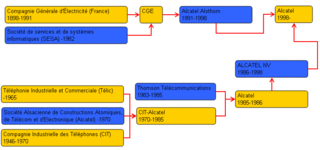
ITT Inc., formerly ITT Corporation, is an American worldwide manufacturing company based in Stamford, Connecticut. The company produces specialty components for the aerospace, transportation, energy and industrial markets. ITT's three businesses include Industrial Process, Motion Technologies, and Connect and Control Technologies.
The Western Electric Company was an American electrical engineering and manufacturing company that operated from 1869 to 1996. A subsidiary of the AT&T Corporation for most of its lifespan, Western Electric was the primary manufacturer, supplier, and purchasing agent for all telephone equipment the Bell System from 1881 until 1984, when the Bell System was dismantled. Because the Bell System had a near-total monopoly over telephone service in the United States for much of the 20th century, Western Electric's equipment was widespread across the country. The company was responsible for many technological innovations, as well as developments in industrial management.

NEC Corporation is a Japanese multinational information technology and electronics corporation, headquartered at the NEC Supertower in Minato, Tokyo, Japan. It provides IT and network solutions, including cloud computing, artificial intelligence (AI), Internet of Things (IoT) platform, and telecommunications equipment and software to business enterprises, communications services providers and to government agencies, and has also been the biggest PC vendor in Japan since the 1980s when it launched the PC-8000 series.
Automatic Electric Company was an American telephone equipment supplier primarily for independent telephone companies in North America, but also had a worldwide presence. With its line of automatic telephone exchanges, it was also a long-term supplier of switching equipment to the Bell System, starting in 1919. The company was the largest manufacturing unit of the Automatic Electric Group. In 1955, the company was acquired by General Telephone and Electronics (GT&E). After numerous reorganization within GTE, the company's assets came under the umbrella of Lucent in the 1990s, and subsequently part of Nokia.

Standard Telephones and Cables Ltd was a British manufacturer of telephone, telegraph, radio, telecommunications, and related equipment. During its history, STC invented and developed several groundbreaking new technologies including pulse-code modulation (PCM) and optical fibres.
Stromberg-Carlson was a United States telecommunications equipment and electronics manufacturing company. It was formed in 1894 as a partnership by Swedish immigrants Alfred Stromberg and Androv Carlson. It was one of five companies that controlled the national supply of telephone equipment until after World War II.

Alcatel–Lucent S.A. was a multinational telecommunications equipment company, headquartered in Boulogne-Billancourt, France. It was formed in 2006 by the merger of France-based Alcatel and U.S.-based Lucent, the latter being a successor of AT&T's Western Electric and a holding company of Bell Labs.

Leich Electric was a manufacturing company of telecommunications equipment in the United States. Leich produced telephone sets, switchboards, telephone exchange equipment, and associated tools and materials for the independent telephone market in the United States and Canada.
The Employers' Association of Greater Chicago (EA) was a nonprofit association of employers based in Chicago, Illinois. It was founded as the Employers' Association of Chicago in 1903, although it was also known colloquially as the Chicago Employers' Association. Its goal was to oppose the unionization of companies in the Chicago area, and assist unionized companies in deunionization.

The 1905 Chicago Teamsters' strike was a sympathy strike and lockout by the United Brotherhood of Teamsters in the summer of 1905 in the city of Chicago, Illinois. The strike was initiated by a small clothing workers' union. But it soon spread as nearly every union in the city, including the Teamsters, supported the job action with sympathy strikes. Initially, the strike was aimed at the Montgomery Ward department store, but it affected almost every employer in the metropolitan region after the Teamsters walked out. The strike eventually pitted the Teamsters against the Employers' Association of Chicago, a broad coalition of business owners formed a few years earlier to oppose unionization in Chicago.

An independent telephone company was a telephone company providing local service in the United States or Canada that was not part of the Bell System organized by American Telephone and Telegraph. Independent telephone companies usually operated in many rural or sparsely populated areas.

The Bell System was a system of telecommunication companies, led by the Bell Telephone Company and later by the American Telephone and Telegraph Company (AT&T), that dominated the telephone services industry in North America for over 100 years from its creation in 1877 until its antitrust breakup in 1983. The system of companies was often colloquially called Ma Bell, as it held a vertical monopoly over telecommunication products and services in most areas of the United States and Canada. At the time of the breakup of the Bell System in the early 1980s, it had assets of $150 billion and employed over one million people.

A telephone exchange, also known as a telephone switch or central office, is a crucial component in the public switched telephone network (PSTN) or large enterprise telecommunications systems. It facilitates the interconnection of telephone subscriber lines or digital system virtual circuits, enabling telephone calls between subscribers.
The International Bell Telephone Company (IBTC) of Brussels, Belgium, was created in 1879 by the Bell Telephone Company of Boston, Massachusetts, a precursor entity to the American Telephone and Telegraph Company (AT&T), initially to sell imported telephones and switchboards in Continental Europe.
Kempster Blanchard Miller was an American engineer, author, and businessman. He is known for his many writings in the field of electrical engineering, electrical design, and the early telephone industry. His best known work was American Telephone Practice, considered for many years to be the seminal textbook on early telephone design and function.
C. Lorenz AG (1880–1958) was a German electrical and electronics firm primarily located in Berlin. It innovated, developed, and marketed products for electric lighting, telegraphy, telephony, radar, and radio. It was acquired by ITT in 1930 and became part of the newly founded company Standard Elektrik Lorenz (SEL) Stuttgart in 1958, when it merged with Standard Elektrizitätsgesellschaft and several other smaller companies owned by ITT. In 1987, SEL merged with the French companies Compagnie Générale d'Electricité and Alcatel to form the new Alcatel SEL.
System 1240 was a new Digital Telephone Exchange developed in 1977 by ITT Corporation. It reportedly cost US$1 billion. It anticipated the features of ISDN of the 1990s.
Wallace Leroy DeWolf, sometimes also written as De Wolf, was an American lawyer, businessman, philanthropist, and artist. He was born in Chicago, Illinois, and spent most of his life in the city. Originally a lawyer, DeWolf founded a successful real estate company in 1894. In 1901, he was named the president of the Kellogg Switchboard & Supply Company. His seven-year tenure featured a stock controversy that reached the Illinois Supreme Court and resulted in a large strike.
The McGraw Electric Company was a US manufacturer of electric appliances founded by Max McGraw in 1900. It grew through mergers and acquisitions to become a major enterprise. The best known product may have been the Toastmaster pop-up toaster. In 1957 McGraw Electric merged with Thomas A. Edison, Inc. to form McGraw-Edison.

Alcatel SA was a French telecommunications company.










